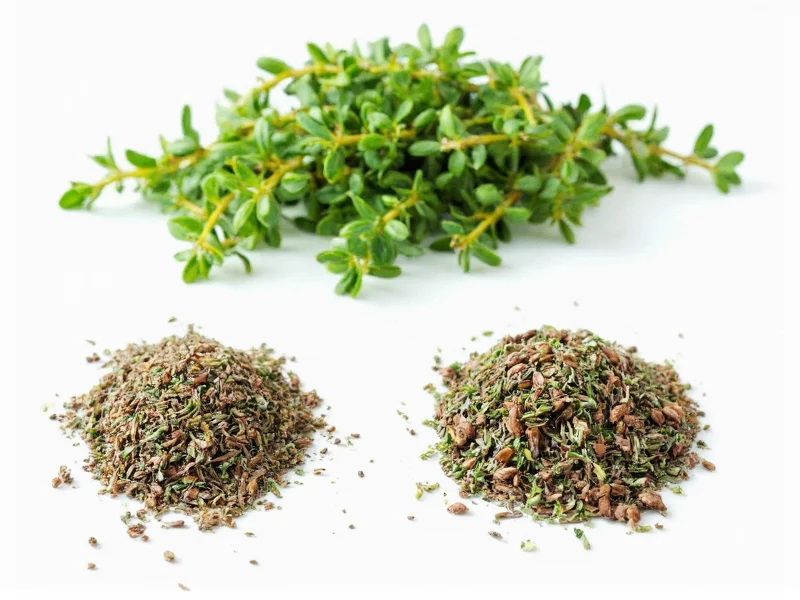The standard conversion ratio is 1 tablespoon of fresh thyme equals 1 teaspoon of dried thyme. This 3:1 ratio accounts for dried thyme's concentrated flavor profile, as the drying process removes moisture while intensifying essential oils. Understanding this fresh thyme to dried thyme conversion ratio ensures recipe accuracy whether you're making roasted vegetables, stews, or marinades.
When substituting fresh thyme for dried in your cooking, precise measurements matter more than many home chefs realize. The difference between a perfectly seasoned dish and an overpowering one often comes down to understanding the fundamental relationship between fresh and dried herbs. Thyme exemplifies this principle particularly well due to its complex aromatic compounds that transform during the drying process.
Why the 3:1 Fresh to Dried Thyme Ratio Works
Thyme's essential oils become significantly more concentrated when moisture is removed through drying. Fresh thyme contains approximately 70-80% water content, which evaporates during the drying process. This concentration effect means dried thyme delivers more potent flavor in a smaller volume. The 3:1 ratio (three parts fresh to one part dried) has been established through culinary testing as the most reliable conversion for maintaining balanced flavor profiles in recipes.
Flavor Profile Differences Between Fresh and Dried Thyme
Fresh thyme offers bright, grassy notes with subtle citrus undertones and a delicate floral quality. Dried thyme develops deeper, earthier characteristics with more pronounced woody and camphor-like notes. The drying process causes certain volatile compounds to evaporate while concentrating others, creating a fundamentally different flavor experience.
Chefs should consider these flavor differences when substituting. In delicate dishes like fish preparations or light sauces, fresh thyme's subtlety might be preferable. For heartier applications like braises, stews, or long-cooking dishes, dried thyme often integrates more seamlessly as its robust flavor withstands extended cooking times.
Practical Conversion Reference
| Fresh Thyme | Dried Thyme Equivalent | Best Used For |
|---|---|---|
| 1 teaspoon | ⅓ teaspoon | Finishing dishes, garnishes |
| 1 tablespoon | 1 teaspoon | Most standard recipes |
| ¼ cup | 1 tablespoon | Large batch cooking |
| 1 cup | ¼ cup | Preserving, seasoning blends |
Substitution Best Practices
When converting fresh thyme to dried in recipes, add dried thyme earlier in the cooking process to allow time for rehydration and flavor release. Dried herbs typically need 15-20 minutes of cooking time to fully express their flavors. For fresh thyme substitutions in recipes calling for dried, add the fresh herb toward the end of cooking to preserve its delicate flavor compounds.
Consider the dish's cooking method when making substitutions. In quick-cooking applications like salad dressings or compound butters, fresh thyme generally provides superior results. For slow-cooked dishes like pot roasts or bean stews, dried thyme often delivers more consistent flavor throughout the cooking process.
Storage Recommendations for Optimal Flavor
Proper storage significantly impacts thyme's shelf life and flavor intensity. Store fresh thyme wrapped in a slightly damp paper towel inside a perforated plastic bag in the refrigerator crisper drawer. This method typically preserves freshness for 10-14 days. For longer storage, freeze fresh thyme sprigs in olive oil using ice cube trays.
Dried thyme maintains best quality for 6-12 months when stored in an airtight container away from light and heat. Glass jars with tight-fitting lids kept in a cool, dark pantry provide ideal conditions. Avoid storing dried herbs above the stove where heat and humidity accelerate flavor degradation.
Common Substitution Mistakes to Avoid
Many home cooks make critical errors when substituting between fresh and dried thyme. The most frequent mistake is using equal measurements rather than adjusting for concentration. Another common error involves substituting at the wrong stage of cooking, resulting in either muted or overpowering flavors.
When converting recipes that call for thyme stems (common with fresh thyme in roasts), remember that dried thyme doesn't have stems to remove. Adjust your technique accordingly—dried thyme integrates completely into dishes while fresh thyme stems often require removal before serving.
Practical Application Examples
Consider a classic Coq au Vin recipe calling for 2 tablespoons of fresh thyme. Using the proper conversion, you'd substitute 2 teaspoons of dried thyme. For a simple lemon-thyme vinaigrette that specifies 1 teaspoon fresh thyme, use ¼ teaspoon dried thyme instead.
In tomato-based dishes like marinara sauce, dried thyme often performs better than fresh due to its ability to withstand acidic environments and longer simmering times. Conversely, fresh thyme shines in applications like herb-infused oils or fresh herb butters where its delicate flavor profile remains intact.











 浙公网安备
33010002000092号
浙公网安备
33010002000092号 浙B2-20120091-4
浙B2-20120091-4